Theories Incorporating Stress: Clinical Practice and Patient Outcomes
VerifiedAdded on 2022/08/14
|9
|1960
|138
Report
AI Summary
This report delves into the application of various stress theories within the context of nursing practice. It begins by defining stress and outlining three key theories: stimulus-based, response-based, and transaction-based models. The report details the development and core principles of each theory, highlighting their influence on clinical approaches and patient outcomes. It explores how these theories are used to address clinical issues, such as anxiety and anger management, and emphasizes the importance of nurses' role in reducing patient stress through communication and education. Furthermore, the report discusses the challenges nurses face in applying these theories, including the lack of empirical evidence and patient non-compliance. The conclusion underscores the significance of cognitive evaluation and adjustment in managing stress, ultimately aiming for improved patient well-being and a stronger, healthier future. The report includes references and an appendix with visual aids illustrating the concepts discussed. The assignment is based on a concept analysis paper utilizing the Walker-Avant method.

Running head: CONCEPTS USE IN NURSING THEORIES
THEORIES THAT INCORPORATE STRESS
Name of the Student
Name of the University
Author note
THEORIES THAT INCORPORATE STRESS
Name of the Student
Name of the University
Author note
Paraphrase This Document
Need a fresh take? Get an instant paraphrase of this document with our AI Paraphraser
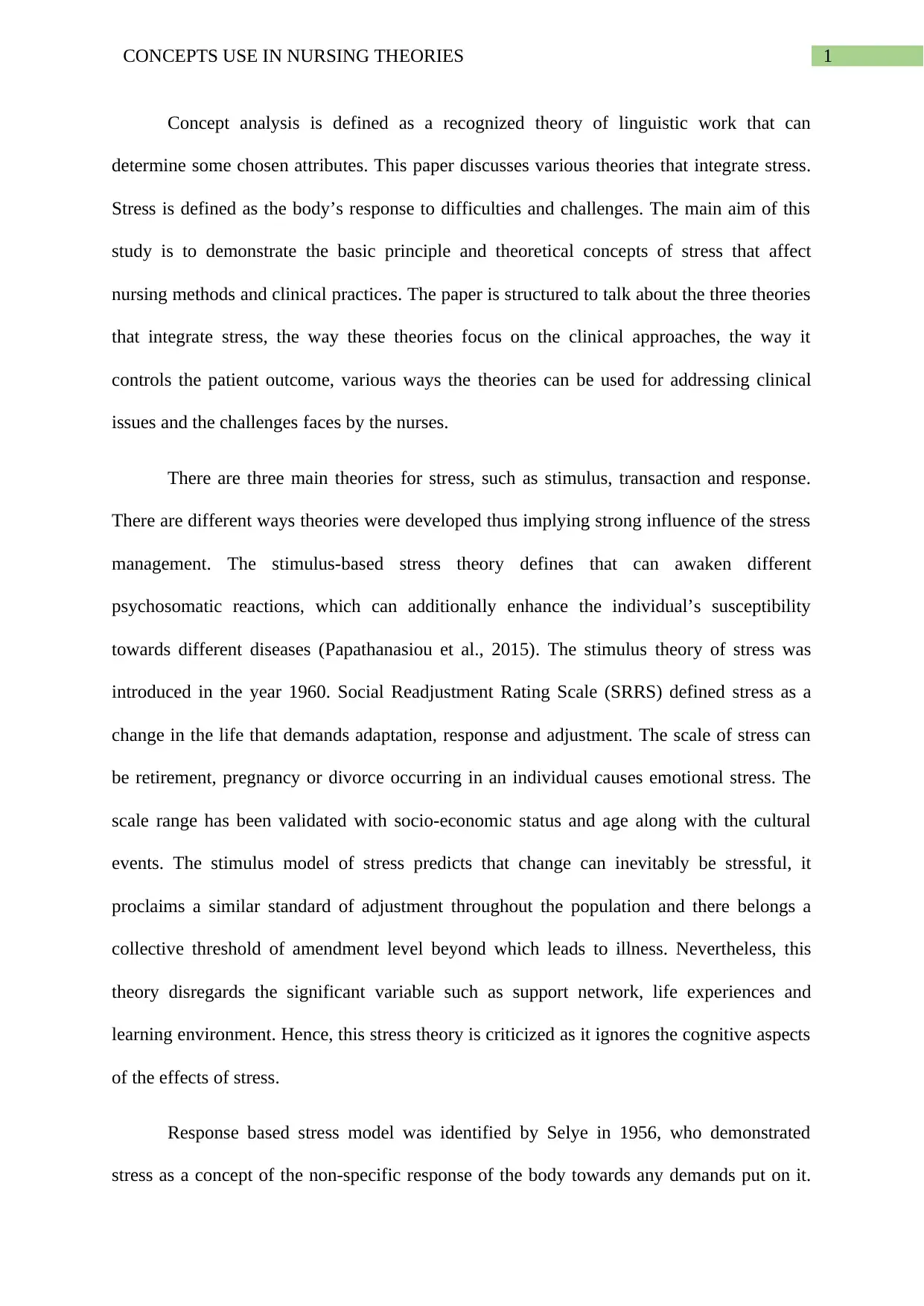
1CONCEPTS USE IN NURSING THEORIES
Concept analysis is defined as a recognized theory of linguistic work that can
determine some chosen attributes. This paper discusses various theories that integrate stress.
Stress is defined as the body’s response to difficulties and challenges. The main aim of this
study is to demonstrate the basic principle and theoretical concepts of stress that affect
nursing methods and clinical practices. The paper is structured to talk about the three theories
that integrate stress, the way these theories focus on the clinical approaches, the way it
controls the patient outcome, various ways the theories can be used for addressing clinical
issues and the challenges faces by the nurses.
There are three main theories for stress, such as stimulus, transaction and response.
There are different ways theories were developed thus implying strong influence of the stress
management. The stimulus-based stress theory defines that can awaken different
psychosomatic reactions, which can additionally enhance the individual’s susceptibility
towards different diseases (Papathanasiou et al., 2015). The stimulus theory of stress was
introduced in the year 1960. Social Readjustment Rating Scale (SRRS) defined stress as a
change in the life that demands adaptation, response and adjustment. The scale of stress can
be retirement, pregnancy or divorce occurring in an individual causes emotional stress. The
scale range has been validated with socio-economic status and age along with the cultural
events. The stimulus model of stress predicts that change can inevitably be stressful, it
proclaims a similar standard of adjustment throughout the population and there belongs a
collective threshold of amendment level beyond which leads to illness. Nevertheless, this
theory disregards the significant variable such as support network, life experiences and
learning environment. Hence, this stress theory is criticized as it ignores the cognitive aspects
of the effects of stress.
Response based stress model was identified by Selye in 1956, who demonstrated
stress as a concept of the non-specific response of the body towards any demands put on it.
Concept analysis is defined as a recognized theory of linguistic work that can
determine some chosen attributes. This paper discusses various theories that integrate stress.
Stress is defined as the body’s response to difficulties and challenges. The main aim of this
study is to demonstrate the basic principle and theoretical concepts of stress that affect
nursing methods and clinical practices. The paper is structured to talk about the three theories
that integrate stress, the way these theories focus on the clinical approaches, the way it
controls the patient outcome, various ways the theories can be used for addressing clinical
issues and the challenges faces by the nurses.
There are three main theories for stress, such as stimulus, transaction and response.
There are different ways theories were developed thus implying strong influence of the stress
management. The stimulus-based stress theory defines that can awaken different
psychosomatic reactions, which can additionally enhance the individual’s susceptibility
towards different diseases (Papathanasiou et al., 2015). The stimulus theory of stress was
introduced in the year 1960. Social Readjustment Rating Scale (SRRS) defined stress as a
change in the life that demands adaptation, response and adjustment. The scale of stress can
be retirement, pregnancy or divorce occurring in an individual causes emotional stress. The
scale range has been validated with socio-economic status and age along with the cultural
events. The stimulus model of stress predicts that change can inevitably be stressful, it
proclaims a similar standard of adjustment throughout the population and there belongs a
collective threshold of amendment level beyond which leads to illness. Nevertheless, this
theory disregards the significant variable such as support network, life experiences and
learning environment. Hence, this stress theory is criticized as it ignores the cognitive aspects
of the effects of stress.
Response based stress model was identified by Selye in 1956, who demonstrated
stress as a concept of the non-specific response of the body towards any demands put on it.

2CONCEPTS USE IN NURSING THEORIES
The model represented by Selye was called General Adaptation Syndrome (GAS). Selye
explained that stress is a condition of the body and it can only be detected when there is any
change (Fisher, 2015). GAS exhibited that with the release of certain hormones, changes
occur in the chemical and structural composition of the body. The response to stress is known
as LAS (Local adaptation syndrome). The response model of stress defines stress as a self-
protective mechanism that includes three stages such as exhaustion, resistance and alarm. It
also demonstrated the fact if there is prolonged stress, then the individual might undergo
death. This response model incorporated the idea of adaptation and coping with the GAS
model. It proved that when stress is confronted with negative stimuli, it initiates alarm
response further activating the sympathetic nervous system to battle stress (Khorshidi,
Shariati & Emam, 2016). The resistance response initiates a physiological system that is
linked with homeostasis thereby accommodating stressor leading to hypertension, heart
disease and mental illness.
The next theory of stress in the transaction, which is founded by Lazarus. Lazarus
focuses on the principle that there are differences within people in identifying stress as a
response or stimulus. Lazarus stated that other theories have a deficiency in interpreting the
factors which can help people in adjusting in every stressful situation. Lazarus acknowledged
that certain environmental situations might cause stress among individuals differing in
vulnerability and sensitivity (Samanta, Gupta & Kundu, 2019). Transaction theory is a
cognitive-based evaluation theory concentrating on the environment, a person as well as on
the immediate intellectual evaluation of ecological demands and motivational response
(Tappen, 2016). The transaction stress model includes primary and secondary appraisal
process. The primary appraisal process regulates the intimidation towards individual whereas
secondary appraisal stress evaluates the Coping resource that include skill, knowledge and
help. People prone to stress get influences by predictability and controllability of events.
The model represented by Selye was called General Adaptation Syndrome (GAS). Selye
explained that stress is a condition of the body and it can only be detected when there is any
change (Fisher, 2015). GAS exhibited that with the release of certain hormones, changes
occur in the chemical and structural composition of the body. The response to stress is known
as LAS (Local adaptation syndrome). The response model of stress defines stress as a self-
protective mechanism that includes three stages such as exhaustion, resistance and alarm. It
also demonstrated the fact if there is prolonged stress, then the individual might undergo
death. This response model incorporated the idea of adaptation and coping with the GAS
model. It proved that when stress is confronted with negative stimuli, it initiates alarm
response further activating the sympathetic nervous system to battle stress (Khorshidi,
Shariati & Emam, 2016). The resistance response initiates a physiological system that is
linked with homeostasis thereby accommodating stressor leading to hypertension, heart
disease and mental illness.
The next theory of stress in the transaction, which is founded by Lazarus. Lazarus
focuses on the principle that there are differences within people in identifying stress as a
response or stimulus. Lazarus stated that other theories have a deficiency in interpreting the
factors which can help people in adjusting in every stressful situation. Lazarus acknowledged
that certain environmental situations might cause stress among individuals differing in
vulnerability and sensitivity (Samanta, Gupta & Kundu, 2019). Transaction theory is a
cognitive-based evaluation theory concentrating on the environment, a person as well as on
the immediate intellectual evaluation of ecological demands and motivational response
(Tappen, 2016). The transaction stress model includes primary and secondary appraisal
process. The primary appraisal process regulates the intimidation towards individual whereas
secondary appraisal stress evaluates the Coping resource that include skill, knowledge and
help. People prone to stress get influences by predictability and controllability of events.
⊘ This is a preview!⊘
Do you want full access?
Subscribe today to unlock all pages.

Trusted by 1+ million students worldwide
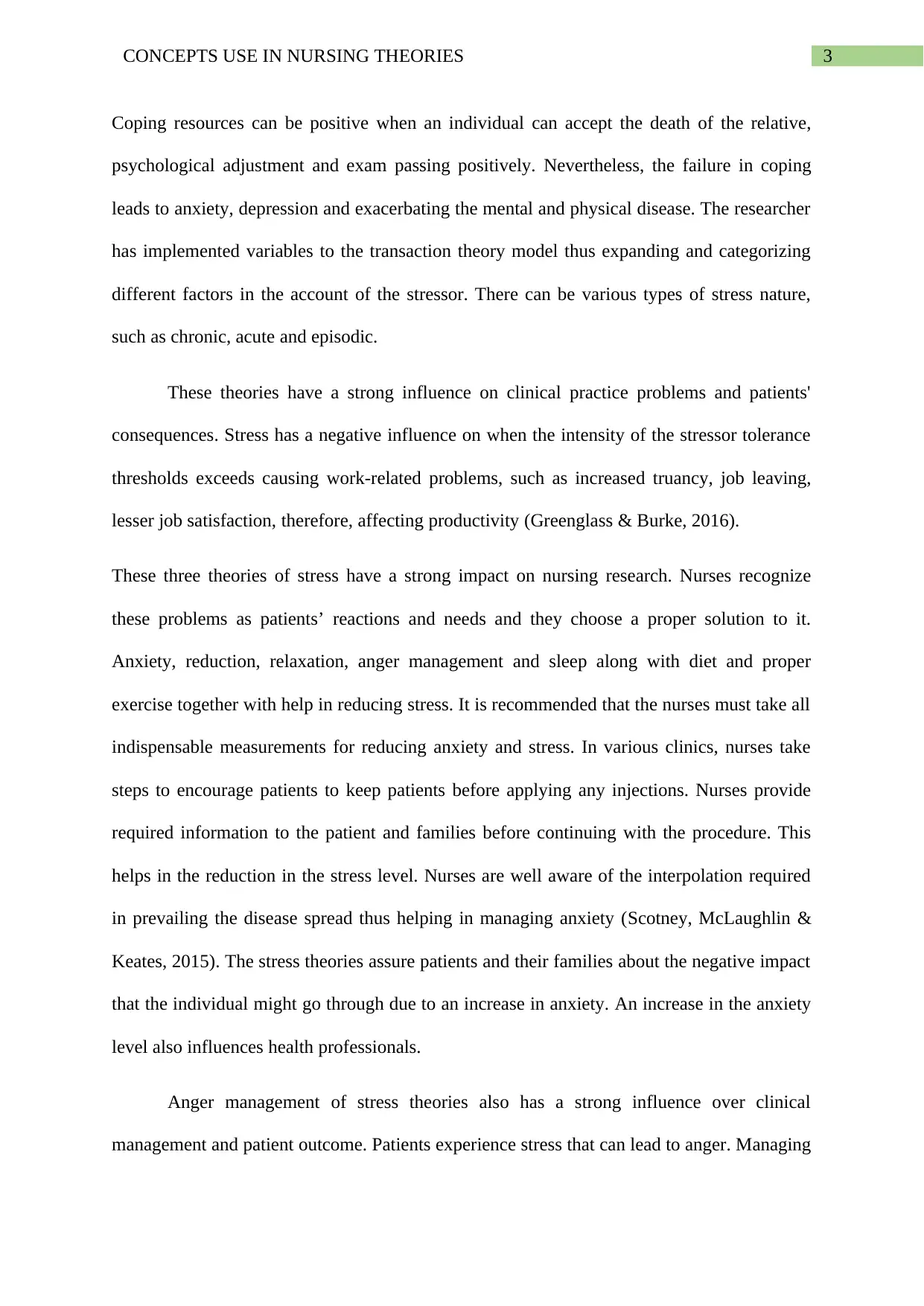
3CONCEPTS USE IN NURSING THEORIES
Coping resources can be positive when an individual can accept the death of the relative,
psychological adjustment and exam passing positively. Nevertheless, the failure in coping
leads to anxiety, depression and exacerbating the mental and physical disease. The researcher
has implemented variables to the transaction theory model thus expanding and categorizing
different factors in the account of the stressor. There can be various types of stress nature,
such as chronic, acute and episodic.
These theories have a strong influence on clinical practice problems and patients'
consequences. Stress has a negative influence on when the intensity of the stressor tolerance
thresholds exceeds causing work-related problems, such as increased truancy, job leaving,
lesser job satisfaction, therefore, affecting productivity (Greenglass & Burke, 2016).
These three theories of stress have a strong impact on nursing research. Nurses recognize
these problems as patients’ reactions and needs and they choose a proper solution to it.
Anxiety, reduction, relaxation, anger management and sleep along with diet and proper
exercise together with help in reducing stress. It is recommended that the nurses must take all
indispensable measurements for reducing anxiety and stress. In various clinics, nurses take
steps to encourage patients to keep patients before applying any injections. Nurses provide
required information to the patient and families before continuing with the procedure. This
helps in the reduction in the stress level. Nurses are well aware of the interpolation required
in prevailing the disease spread thus helping in managing anxiety (Scotney, McLaughlin &
Keates, 2015). The stress theories assure patients and their families about the negative impact
that the individual might go through due to an increase in anxiety. An increase in the anxiety
level also influences health professionals.
Anger management of stress theories also has a strong influence over clinical
management and patient outcome. Patients experience stress that can lead to anger. Managing
Coping resources can be positive when an individual can accept the death of the relative,
psychological adjustment and exam passing positively. Nevertheless, the failure in coping
leads to anxiety, depression and exacerbating the mental and physical disease. The researcher
has implemented variables to the transaction theory model thus expanding and categorizing
different factors in the account of the stressor. There can be various types of stress nature,
such as chronic, acute and episodic.
These theories have a strong influence on clinical practice problems and patients'
consequences. Stress has a negative influence on when the intensity of the stressor tolerance
thresholds exceeds causing work-related problems, such as increased truancy, job leaving,
lesser job satisfaction, therefore, affecting productivity (Greenglass & Burke, 2016).
These three theories of stress have a strong impact on nursing research. Nurses recognize
these problems as patients’ reactions and needs and they choose a proper solution to it.
Anxiety, reduction, relaxation, anger management and sleep along with diet and proper
exercise together with help in reducing stress. It is recommended that the nurses must take all
indispensable measurements for reducing anxiety and stress. In various clinics, nurses take
steps to encourage patients to keep patients before applying any injections. Nurses provide
required information to the patient and families before continuing with the procedure. This
helps in the reduction in the stress level. Nurses are well aware of the interpolation required
in prevailing the disease spread thus helping in managing anxiety (Scotney, McLaughlin &
Keates, 2015). The stress theories assure patients and their families about the negative impact
that the individual might go through due to an increase in anxiety. An increase in the anxiety
level also influences health professionals.
Anger management of stress theories also has a strong influence over clinical
management and patient outcome. Patients experience stress that can lead to anger. Managing
Paraphrase This Document
Need a fresh take? Get an instant paraphrase of this document with our AI Paraphraser
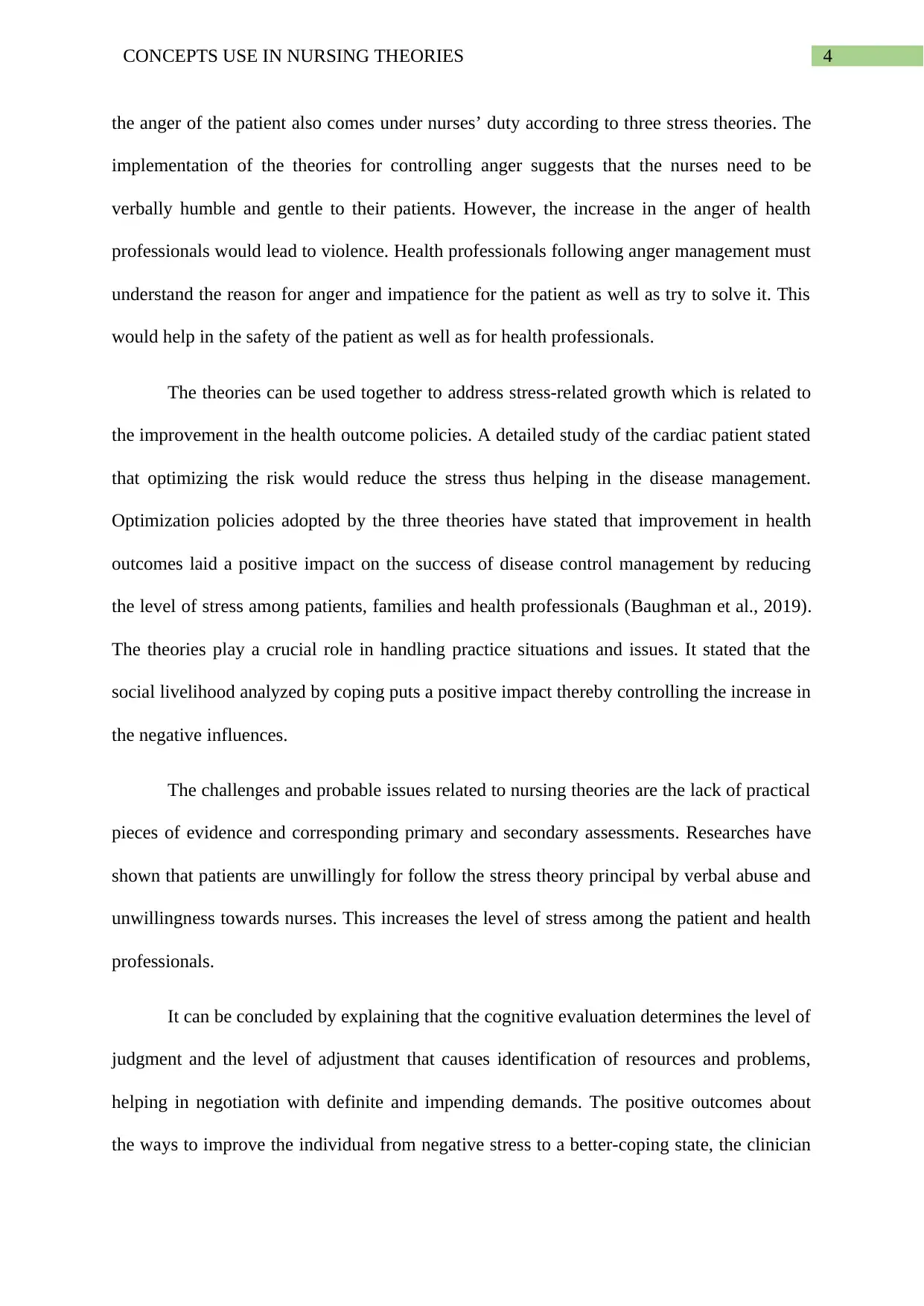
4CONCEPTS USE IN NURSING THEORIES
the anger of the patient also comes under nurses’ duty according to three stress theories. The
implementation of the theories for controlling anger suggests that the nurses need to be
verbally humble and gentle to their patients. However, the increase in the anger of health
professionals would lead to violence. Health professionals following anger management must
understand the reason for anger and impatience for the patient as well as try to solve it. This
would help in the safety of the patient as well as for health professionals.
The theories can be used together to address stress-related growth which is related to
the improvement in the health outcome policies. A detailed study of the cardiac patient stated
that optimizing the risk would reduce the stress thus helping in the disease management.
Optimization policies adopted by the three theories have stated that improvement in health
outcomes laid a positive impact on the success of disease control management by reducing
the level of stress among patients, families and health professionals (Baughman et al., 2019).
The theories play a crucial role in handling practice situations and issues. It stated that the
social livelihood analyzed by coping puts a positive impact thereby controlling the increase in
the negative influences.
The challenges and probable issues related to nursing theories are the lack of practical
pieces of evidence and corresponding primary and secondary assessments. Researches have
shown that patients are unwillingly for follow the stress theory principal by verbal abuse and
unwillingness towards nurses. This increases the level of stress among the patient and health
professionals.
It can be concluded by explaining that the cognitive evaluation determines the level of
judgment and the level of adjustment that causes identification of resources and problems,
helping in negotiation with definite and impending demands. The positive outcomes about
the ways to improve the individual from negative stress to a better-coping state, the clinician
the anger of the patient also comes under nurses’ duty according to three stress theories. The
implementation of the theories for controlling anger suggests that the nurses need to be
verbally humble and gentle to their patients. However, the increase in the anger of health
professionals would lead to violence. Health professionals following anger management must
understand the reason for anger and impatience for the patient as well as try to solve it. This
would help in the safety of the patient as well as for health professionals.
The theories can be used together to address stress-related growth which is related to
the improvement in the health outcome policies. A detailed study of the cardiac patient stated
that optimizing the risk would reduce the stress thus helping in the disease management.
Optimization policies adopted by the three theories have stated that improvement in health
outcomes laid a positive impact on the success of disease control management by reducing
the level of stress among patients, families and health professionals (Baughman et al., 2019).
The theories play a crucial role in handling practice situations and issues. It stated that the
social livelihood analyzed by coping puts a positive impact thereby controlling the increase in
the negative influences.
The challenges and probable issues related to nursing theories are the lack of practical
pieces of evidence and corresponding primary and secondary assessments. Researches have
shown that patients are unwillingly for follow the stress theory principal by verbal abuse and
unwillingness towards nurses. This increases the level of stress among the patient and health
professionals.
It can be concluded by explaining that the cognitive evaluation determines the level of
judgment and the level of adjustment that causes identification of resources and problems,
helping in negotiation with definite and impending demands. The positive outcomes about
the ways to improve the individual from negative stress to a better-coping state, the clinician

5CONCEPTS USE IN NURSING THEORIES
launches a silent scheme of management for the patients. This shrinks negative stress effects
by fulfilling the consequences for a productive, healthier and stronger future.
launches a silent scheme of management for the patients. This shrinks negative stress effects
by fulfilling the consequences for a productive, healthier and stronger future.
⊘ This is a preview!⊘
Do you want full access?
Subscribe today to unlock all pages.

Trusted by 1+ million students worldwide
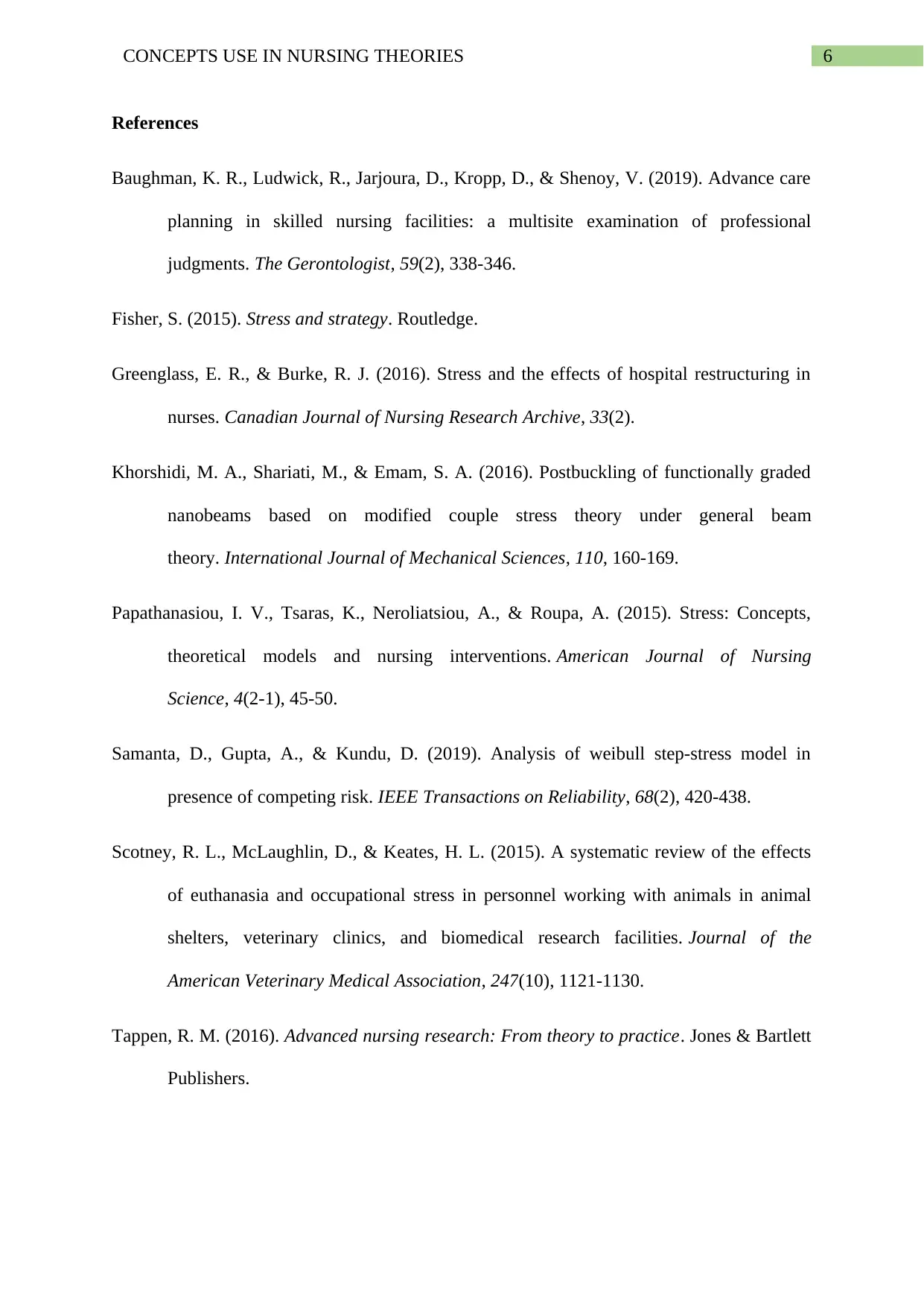
6CONCEPTS USE IN NURSING THEORIES
References
Baughman, K. R., Ludwick, R., Jarjoura, D., Kropp, D., & Shenoy, V. (2019). Advance care
planning in skilled nursing facilities: a multisite examination of professional
judgments. The Gerontologist, 59(2), 338-346.
Fisher, S. (2015). Stress and strategy. Routledge.
Greenglass, E. R., & Burke, R. J. (2016). Stress and the effects of hospital restructuring in
nurses. Canadian Journal of Nursing Research Archive, 33(2).
Khorshidi, M. A., Shariati, M., & Emam, S. A. (2016). Postbuckling of functionally graded
nanobeams based on modified couple stress theory under general beam
theory. International Journal of Mechanical Sciences, 110, 160-169.
Papathanasiou, I. V., Tsaras, K., Neroliatsiou, A., & Roupa, A. (2015). Stress: Concepts,
theoretical models and nursing interventions. American Journal of Nursing
Science, 4(2-1), 45-50.
Samanta, D., Gupta, A., & Kundu, D. (2019). Analysis of weibull step-stress model in
presence of competing risk. IEEE Transactions on Reliability, 68(2), 420-438.
Scotney, R. L., McLaughlin, D., & Keates, H. L. (2015). A systematic review of the effects
of euthanasia and occupational stress in personnel working with animals in animal
shelters, veterinary clinics, and biomedical research facilities. Journal of the
American Veterinary Medical Association, 247(10), 1121-1130.
Tappen, R. M. (2016). Advanced nursing research: From theory to practice. Jones & Bartlett
Publishers.
References
Baughman, K. R., Ludwick, R., Jarjoura, D., Kropp, D., & Shenoy, V. (2019). Advance care
planning in skilled nursing facilities: a multisite examination of professional
judgments. The Gerontologist, 59(2), 338-346.
Fisher, S. (2015). Stress and strategy. Routledge.
Greenglass, E. R., & Burke, R. J. (2016). Stress and the effects of hospital restructuring in
nurses. Canadian Journal of Nursing Research Archive, 33(2).
Khorshidi, M. A., Shariati, M., & Emam, S. A. (2016). Postbuckling of functionally graded
nanobeams based on modified couple stress theory under general beam
theory. International Journal of Mechanical Sciences, 110, 160-169.
Papathanasiou, I. V., Tsaras, K., Neroliatsiou, A., & Roupa, A. (2015). Stress: Concepts,
theoretical models and nursing interventions. American Journal of Nursing
Science, 4(2-1), 45-50.
Samanta, D., Gupta, A., & Kundu, D. (2019). Analysis of weibull step-stress model in
presence of competing risk. IEEE Transactions on Reliability, 68(2), 420-438.
Scotney, R. L., McLaughlin, D., & Keates, H. L. (2015). A systematic review of the effects
of euthanasia and occupational stress in personnel working with animals in animal
shelters, veterinary clinics, and biomedical research facilities. Journal of the
American Veterinary Medical Association, 247(10), 1121-1130.
Tappen, R. M. (2016). Advanced nursing research: From theory to practice. Jones & Bartlett
Publishers.
Paraphrase This Document
Need a fresh take? Get an instant paraphrase of this document with our AI Paraphraser
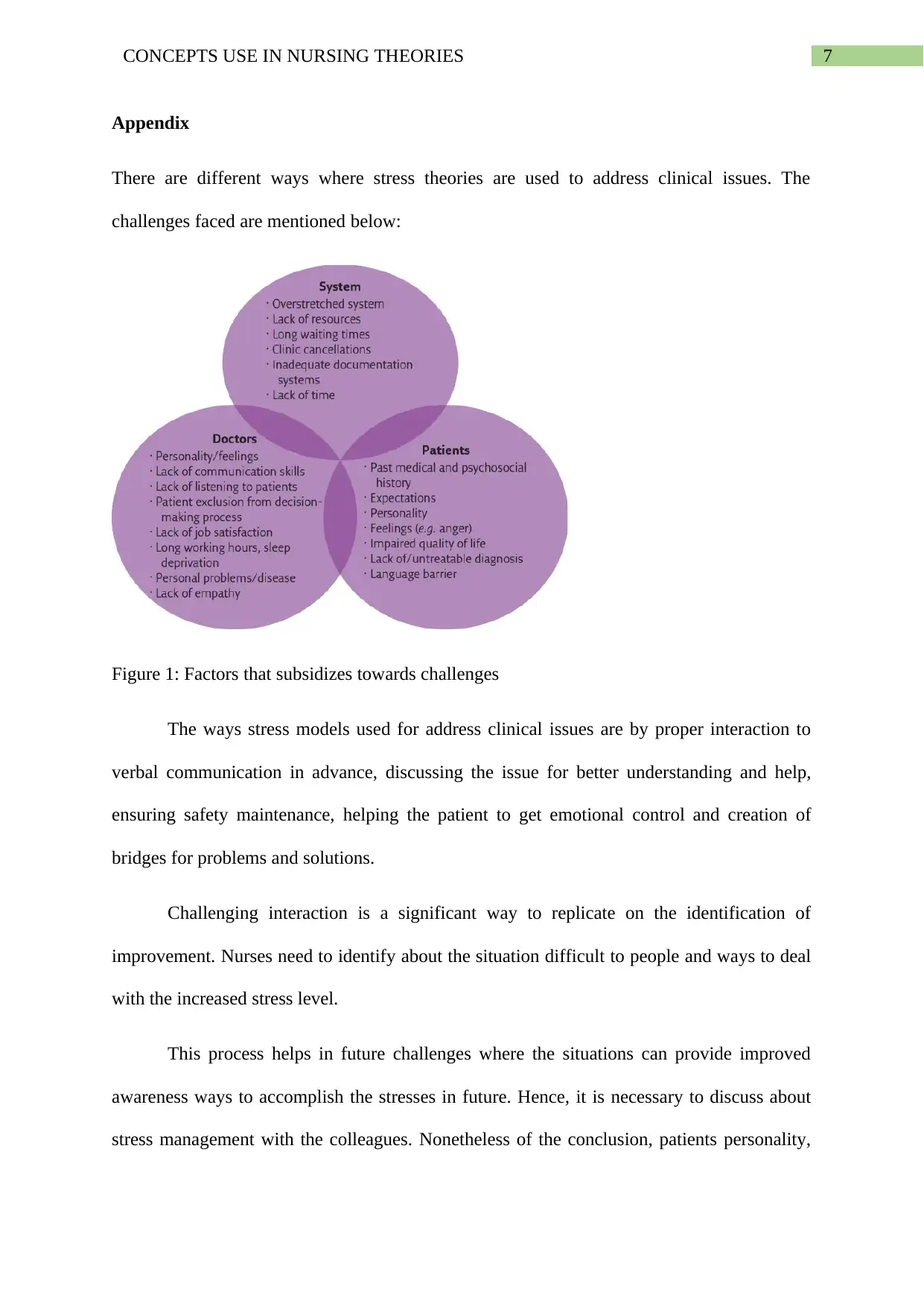
7CONCEPTS USE IN NURSING THEORIES
Appendix
There are different ways where stress theories are used to address clinical issues. The
challenges faced are mentioned below:
Figure 1: Factors that subsidizes towards challenges
The ways stress models used for address clinical issues are by proper interaction to
verbal communication in advance, discussing the issue for better understanding and help,
ensuring safety maintenance, helping the patient to get emotional control and creation of
bridges for problems and solutions.
Challenging interaction is a significant way to replicate on the identification of
improvement. Nurses need to identify about the situation difficult to people and ways to deal
with the increased stress level.
This process helps in future challenges where the situations can provide improved
awareness ways to accomplish the stresses in future. Hence, it is necessary to discuss about
stress management with the colleagues. Nonetheless of the conclusion, patients personality,
Appendix
There are different ways where stress theories are used to address clinical issues. The
challenges faced are mentioned below:
Figure 1: Factors that subsidizes towards challenges
The ways stress models used for address clinical issues are by proper interaction to
verbal communication in advance, discussing the issue for better understanding and help,
ensuring safety maintenance, helping the patient to get emotional control and creation of
bridges for problems and solutions.
Challenging interaction is a significant way to replicate on the identification of
improvement. Nurses need to identify about the situation difficult to people and ways to deal
with the increased stress level.
This process helps in future challenges where the situations can provide improved
awareness ways to accomplish the stresses in future. Hence, it is necessary to discuss about
stress management with the colleagues. Nonetheless of the conclusion, patients personality,
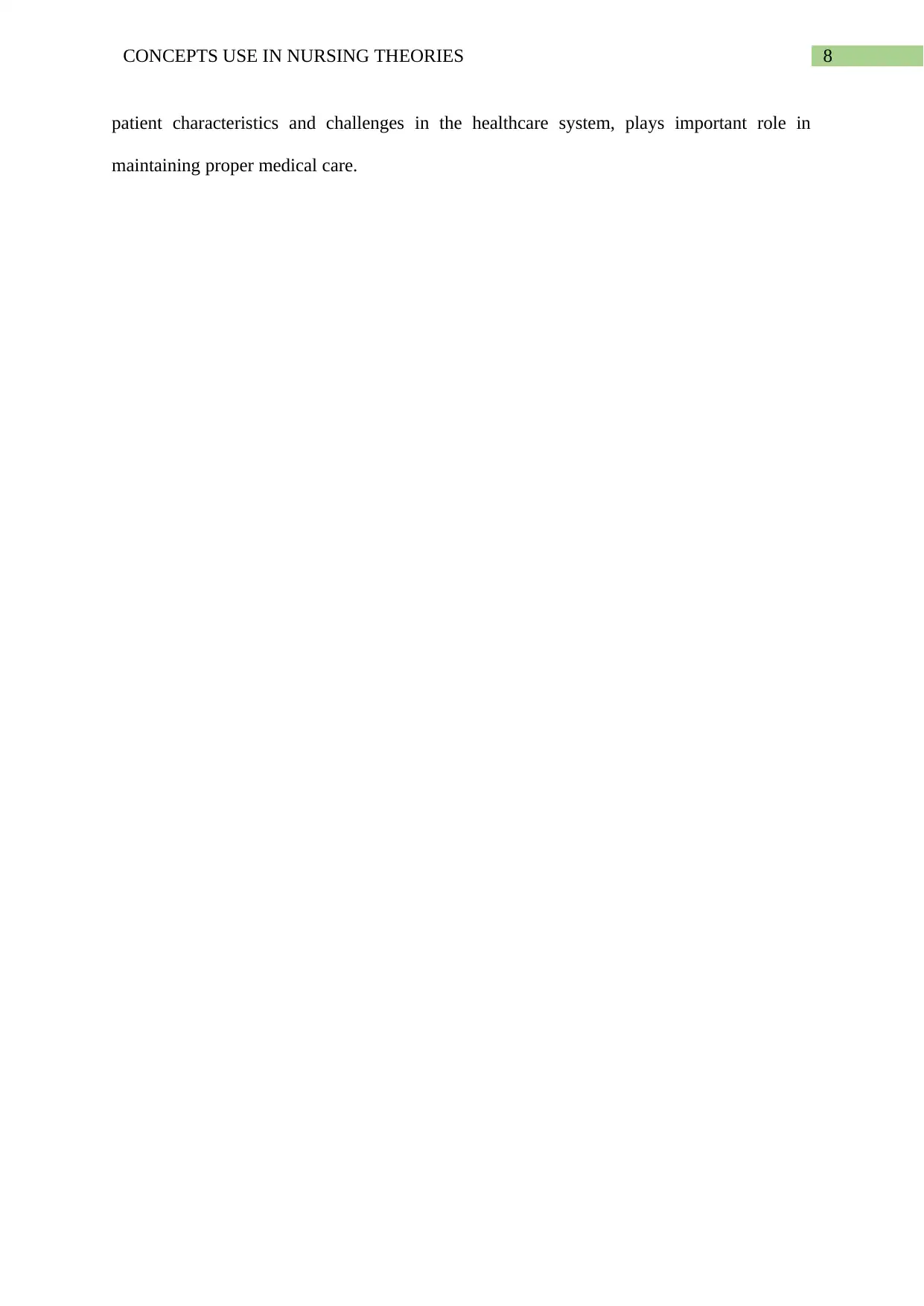
8CONCEPTS USE IN NURSING THEORIES
patient characteristics and challenges in the healthcare system, plays important role in
maintaining proper medical care.
patient characteristics and challenges in the healthcare system, plays important role in
maintaining proper medical care.
⊘ This is a preview!⊘
Do you want full access?
Subscribe today to unlock all pages.

Trusted by 1+ million students worldwide
1 out of 9
Related Documents
Your All-in-One AI-Powered Toolkit for Academic Success.
+13062052269
info@desklib.com
Available 24*7 on WhatsApp / Email
![[object Object]](/_next/static/media/star-bottom.7253800d.svg)
Unlock your academic potential
Copyright © 2020–2025 A2Z Services. All Rights Reserved. Developed and managed by ZUCOL.





